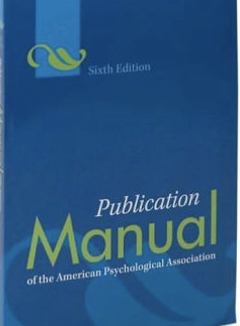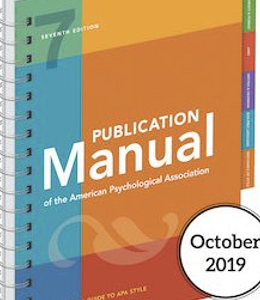What's New in the APA 7th Edition?
(A Work in Progress)
This presentation is an 'open resource' and can be accessed and used by faculty and graduate students in the transition to changes in the APA Publication Manual, 7th Edition. There are no fees or registration required. Dissertation Perfection, LLC views this site as a contribution to our profession and the future DTBs (Dr. To Be) we work with. Permission is granted for faculty to use and also share with graduate courses. In return, DP asks for the sharing of any additional changes we may not have included below. We are 'a work in progress.'
Email: dissertationperfection@gmail.com with any suggestions for addition or improvement.
The APA 6th Edition, our guidelines for scholarly writing was first published in 2009. Here we are 10 years later - sure is time for some updates and revisions in a style manual, especially due to the increase in online media, bias-free language, and the need for a less cumbersome way to cite sources in both text and reference sections. This site will highlight the most significant changes in the new APA 7th Edition (October 2019). Special attention will be given to the writing of dissertations and masters theses. Below, we show several new revisions, with a comparison of the 6th style and the 7th Edition style.
From the 6th Edition to....

the 7th Edition.

Reference
American Psychological Association. (2020). Publication manual of the American Psychological Association (7th ed.). https://doi.org/10.1037/0000165-000
Spaces between sentences (p. 154)
The 7th Edition now requires one space after the period in each sentence.
Example: Research suggests a duplication of study. The literature review addresses this issue.
Publisher location (p. 290)
The 6th Edition required the inclusion of the publication's location.Covey, S. R. (2013). The 7 habits of highly effective people: Powerful
lessons in personal change. New York, NY: Simon & Schuster.
The 7th Edition does not include the publisher's location.
Covey, S. R. (2013). The 7 habits of highly effective people: Powerful lessons in personal change. Simon & Schuster.
Ebooks no longer require the type of ebook to be listed (e.g., PDF, Kindle, etc.) (p. 321)
Green, J. (2018). The fault in our stars [Kindle Version}. Retrieved from: https://amazon.com/Fault-Our-Stars-John-Green-ebook/dp/B007Z8ZKS2/
Green, J. (2018). The fault in our stars: https://amazon.com/Fault-Our-Stars-John-Green-ebook/dp/B007Z8ZKS2/
Website URLs remove "Retrieved from" (p. 299)
Kluger, J. (2019, July 18). Elon Musk told us why he thinks we can land on the Moon in ‘less than 2 years.’ Retrieved from Time website: https://time.com/5628572/elon-musk-moon-landing/
Kluger, J. (2019, July 18). Elon Musk told us why he thinks we can land on the Moon in ‘less than 2 years.' Time website: https://time.com/5628572/elon-musk-moon-landing/
(special note: Do not place a period after URLs as this often restricts the online access)
Journal DOIs are now displayed as a doi.org URL instead of with the "DOI:" prefix. (p. 300)
McCauley, S.M., & Christenson, M.H. (2019). Language learning as language use: A cross-linguistic model of child language development. Psychological Review, 127 (1), 1-51. DOI: 10.1371/journal.pmed.1001226
McCauley, S.M., & Christenson, M.H. (2019). Language learning as language use: A cross-linguistic model of child language development. Psychological Review, 127 (1), 1-51. https://doi.org/10.10137/rev0000126
Three or more authors to include
in-text citations as the first author, "et al."
The same applies when the authors are groups (p. 266)
The 6th Edition required six or more authors for using et al. (Creighton, Yates, Davis, Smith, & Mattocks, 2019)
The 7th Edition reduces that requirement to three or more (Creighton et al., 2019)
(American Association of School Administrators, National Education Association, & National Council of Professors of Educational Administration, 2011).
(American Association of School Administrators et al., 2011)
Tables and Figures now follow the same structure (p. 195)
The 6th Edition required a completely different format for Tables opposed to Figures: Tables were titled on top and Figures titled on the bottom. Tables italicized the title and Figures italicized the figure number. Table titles were all capped; Figure titles were not capped (quite confusing).
With the APA 7th Edition, Tables and Figures now follow the same structure (both titled on top of the table or figure), with the title italicized but not the number with a line space between the Table Number and the Table Title (and flush left - not centered or indented). Tables and Figures may now be presented either in the text of the document or after the reference list on separate pages (see Section 2.14). Notes for each are placed below the Table and/or Figure. Here is an example of each:
Table 1
Number of Children Attending Charter Schools in North Carolina
Figure 1
Mean Math Scores for Fourth Grade Students
A variety of font choices are permitted in APA 7th (p. 44)
The 6th Edition recommended serif-font 12-point Times New Roman.
The APA 7th Edition suggests the following options: (1) a sans serif font such as 11-point Calibri, 11-point Arial, or 10-point Lucida Sans Unicode or (2) a serif-font such as 12-point Times New Roman, 11-point Georgia or normal (10-point) Computer Modern (Note: follow the recommendation of your instructor or institution).
Format for levels of headings (p. 48)
Heading levels 3, 4, and 5 are updated in 7th Edition to improve readability. Most common is the use of three headings (1,2,3). All headings are now bold and title case (Cap all principal words and lower case for articles, conjunctions, and prepositions).
The 6th Edition, Level 1 and Level 2 same as the new 7th Edition.
Heading levels 3, 4, and 5 are updated to improve readability. All headings are now bold and title case.
(Text begins a new para)
(Text begins a new para)
Level 4: Indented, Bold, Title Case, Ending with Period. Text begins on same line and continues as a para.
Level 5: Indented, Bold Italic, Title Case, Ending with Period. Text begins on same line and continues as a para.
Reducing Bias by Topic (p. 135-147)
Little mention of bias-free language is mentioned in APA 6th Edition. Writing inclusively and without bias is the new standard, and the APA 7th Edition contains a separate chapter on this topic. Most of the following should be reported in the Methodology section of dissertation or thesis.
Age
Inappropriate: Participants were over 60 (be more specific - avoid ope-ended ranges such as: under 18 or over 60).
Age - Be more specific
More appropriate: Participants were from age 60 - 75 or from 15-18.
Disability
Avoid negative and condescending terms such as "brain-damaged" or "low I.Q."
Disability - Be more sensitive
More appropriate: persons with traumatic brain injuries or persons with learning disabilities.
Gender: Avoid he/she/his/her
A faculty's career depends on how much he has published.
Gender: Use the form 'they' 'them' 'theirs'
More appropriate: A faculty's career depends on how much they have published.
What is Anthropomorphism? (p. 117)
Examples of Anthropomorphism
1. The study explored the turnover of teachers in large urban school districts?
2. The manuscript discussed the importance of teacher preparation programs.
3. Research has found that parents want safe schools for their children.
Suggested Corrections
1. The investigator explored the turnover of teachers in large urban school districts.
2. Johnson (2020) discussed the importance of teacher preparation programs.
3. Researchers have found that parents want safe schools for their children.
Rationale
1. A person explores, not a thing or an inanimate object such as a study.
2. A manuscript cannot discuss, it is simply a written composition, but writers/authors can.
3. Research does not really find - it is simply an investigation. Authors or researchers find.
Hyperlinks or No Hyperlinks?
In your word-processing program, you’ve probably encountered the automatic hyperlink: Type a URL, and the software immediately underlines it and changes the font color to blue or red (whether you like it or not). Is this something that needs to be “fixed” in an APA Style paper? The APA Publication Manual (6th ed.) and APA Publication Manual (7th ed.) contain no guidelines about this. If a document is to be distributed and read electronically active hyperlinks may be useful. However, common sense tells us that an active hyperlink is of no use in a document intended to be read on paper (e.g., dissertations, books, journals). Furthermore, the default blue color for active hyperlinks usually prints as gray, making them difficult to read. The underlining and color are distracting as well. Most problematic is the 'coming and going' of active links - active when you collected your research but often publishers and their websites are out of business and links are inactive. Therefore, it seems reasonable to avoid the use of active hyperlinks in documents that will be read in print. Since there's no rule governing the use of hyperlinks, take your audience and your delivery method into account when deciding whether URLs should become active hyperlinks in your writing.
2. Scroll down and select Remove Hyperlink
Removing on a Mac (in Word):
3. In the next box, select Remove Hyperlink
Note: What if a reader wants to visit a site you reference? Simple - Select the URL, copy, and paste into one's browser.
What is Italicized (and not Italicized)
in APA 7th?
In APA 7, you italicize titles of sources that stand alone. Standalone sources are not part of another work. Standalone works that you italicize in APA include:
- Books
- Films
- Journal Titles (not journal articles)
- Magazine Title
- Music Album (not a song on the album)
- Newspaper Title
- Podcast (not a podcast episode)
- Photo/Image/Painting
- Reports
- Television Series
- Video
- Webinar
- Webpages/Websites
- YouTube Video
- etc.
Works that are just a part of another work, like a chapter in a book, are not italicized. Sources that are part of another work and in regular font in APA include:
- Edited Book Chapters
- Journal Articles
- Magazine Articles
- Newspaper Articles
- Podcast episodes
- Short stories
- Songs on an album
- Television episodes
- etc.
Statistical Terms versus Words
First, we want to review the difference between a statistical word and a statistical symbol. Let's say we are using the word mean vs the symbol and use in a sentence such as: The mean score was 3.4. If however, we use the symbol which is M in the sentence, the M must be italicized. Here is a shortlist of common statistical words along with statistical symbols:
Statistical words (not in italics) Statistical symbol (italicized)
The mean score was 47. The result of the study was M = 47.
The number of applicants was 12. The result of the study was N = 12.
The median of the sample was 36. The median was Mdn = 36.
Note: See a complete list of Statistical Abbreviations and Symbols in the APA 7th Manual on pages 183-186.